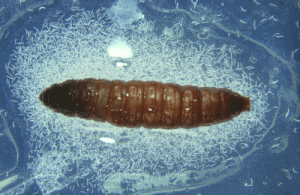Heterorhabditis bacteriophora is a nematode. A simple roundworm. Colorless, unsegmented, with no appendages, it eats bacteria.
So why do they make great biological insecticides?
They are farmers. They have a symbiotic relationship with the bacteria that they eat. The bacteria like to live inside insect hosts, which they kill and eat. The nematodes eat the bacteria, and then when the insect is eaten up, the nematodes carry some of the bacteria to a new insect. They then regurgitate the bacteria inside the insect, to seed their bacteria farm.
The nematodes are harmless to plants and mammals, but quite deadly to many soil insect pests. They target dozens of harmful pests, yet have no effect on bees and other beneficial pollinators.
Because they are microscopic metazoans, they can be mixed with water and sprayed using common pesticide equipment. They can be grown in standard fermentation tanks up to 40,000 gallons.
The bacterial symbiotes are Photorhabdus luminescens. They kill the host insect quickly, in one to two days. They need the nematode in order to enter the host insect, and the nematode can carry them much longer distances than they could travel alone. In return, the bacteria provide an environment in the host insect that the nematode needs for survival and reproduction. The bacteria produce immune suppressing proteins that prevent the insect from killing off the nematodes, and they produce anti-microbial molecules that prevent other bacteria from colonizing the dead insect.
As biological controls, the nematodes have some advantages over chemical pesticides. They aren’t toxic to mammals, and they don’t pollute the ground water, and they target only specific pests. On the downside, they are living creatures, and are harmed by drying out, ultraviolet light or heat, and they can’t be stored for long periods.
Another plus for the worms is that you can tell if an insect was killed by them. The bacteria glow (hence the name luminescens).
